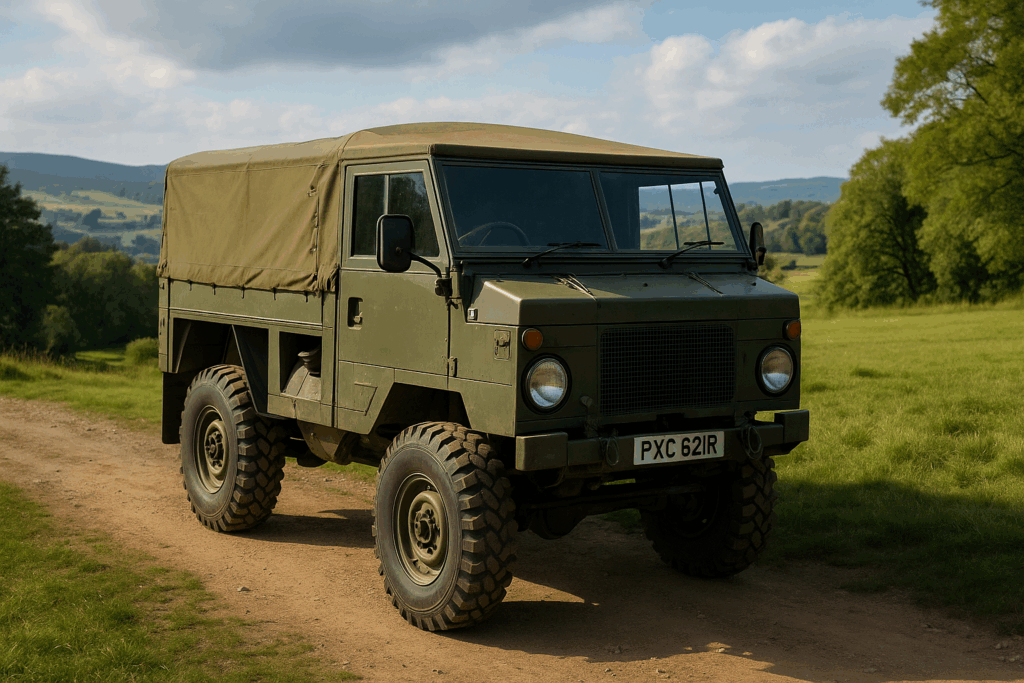
Table of Contents
- Overview
- Production and Purpose
- Design Specifications
- Transmission
- Weight and Capacity
- Towing Capability
- Drive and Suspension
- Performance
- Aerial Transportability
- References
Overview
The Land Rover 101 Forward Control, or 101FC, is a military vehicle produced in the 1970s. Designed for versatility and robust performance, it features a 101-inch wheelbase, a 3.5-liter Rover V8 engine producing about 135 bhp, and permanent four-wheel drive. With a payload capacity of one tonne and a towing capacity of 1.8 tonnes, it was primarily used for transporting military loads such as ammunition. Its design allows for easy air transport, fitting into standard RAF aircraft. If you own one and want to show off you might like our 101FC t-shirts.
Production and Purpose
The Land Rover 101 Forward Control (101FC) was produced between 1972 and 1978. During its production run, a total of 2,669 units were delivered. These vehicles were primarily built for military use, specifically designed to meet the needs of the British Army.
The primary purpose of the 101FC was to serve as a general service vehicle with the capability to carry substantial loads across challenging terrains. Its main role was to transport military supplies, particularly ammunition for artillery units.
Design Specifications
- Wheelbase: The vehicle has a wheelbase of 101 inches (2565 mm), which provides stability and maneuverability essential for off-road operations.
- Engine: It is powered by a 3.5-litre Rover V8 engine.
- Horsepower: The engine produces approximately 135 bhp (brake horsepower).
Transmission
- Transmission Type: The 101FC is equipped with an LT95 transmission.
- Gearbox: The LT95 includes a four-speed gearbox.
- Transfer Case: It also features a two-speed transfer case, enhancing its capability to handle diverse driving conditions.
Weight and Capacity
- Curb Weight: The curb weight of the vehicle is approximately 5,300 lbs (2404 kg).
- Payload Capacity: It has a payload capacity of one ton (2000 lbs or 907 kg), allowing it to carry significant loads without compromising performance.
Towing Capability
- Towing Capacity: The Land Rover 101FC boasts a towing capacity of over 4000 lbs (1814 kg), making it suitable for hauling additional equipment or trailers as needed in military operations.
Drive and Suspension
- Drive System: The vehicle is equipped with permanent four-wheel drive, ensuring all wheels receive power at all times for optimal traction on rough terrain.
- Suspension: Both front and rear suspensions are coil-sprung, providing enhanced comfort and stability during movement over uneven ground.
Performance
- Top Speed: The top speed of the Land Rover 101FC ranges from around 60 to 70mph. This range allows for both steady transportation on highways and controlled movement in more tactical settings where lower speeds may be necessary due to terrain or operational requirements.
Aerial Transportability
- Aerial Transportability: Designed with military logistics in mind, one notable feature of the LXIX FC
The 101’s aerial transportability. Its dimensions allow it to be easily loaded onto aircraft without requiring extensive modifications or disassembly—a critical attribute for rapid deployment scenarios where speed is essential.
This capability ensures that troops can have reliable ground transportation immediately upon landing in various operational theaters worldwide.
Military Utilization
Primary Role:
The primary utilization within military contexts was as an ammunition carrier—specifically designed to support gun detachments by transporting necessary munitions efficiently across different battlefield environments.
General Service Vehicle:
Beyond its role as an ammunition carrier, the 101FC also served as a general service vehicle capable of fulfilling multiple logistical roles within armed forces due to its robust design and versatile capabilities.
Conclusion
The Land Rover 101 FC stands out due to its limited production numbers yet significant impact within military circles thanks largely to its specialized design features tailored towards enhancing operational effectiveness—from powerful engine specifications through advanced suspension systems down towards unique attributes like aerial transportability—all contributing towards making this model highly valued among collectors today while remaining historically important within defense sectors globally.
Frequently Asked Questions
What is the payload capacity of the Land Rover 101 Forward Control?
The Land Rover 101 Forward Control has a payload capacity of one ton, which is approximately 2,000 lbs (907 kg).
Can the 101FC be used for towing?
Yes, the 101FC has a towing capacity of over 4,000 lbs (1,814 kg), making it suitable for various towing tasks.
